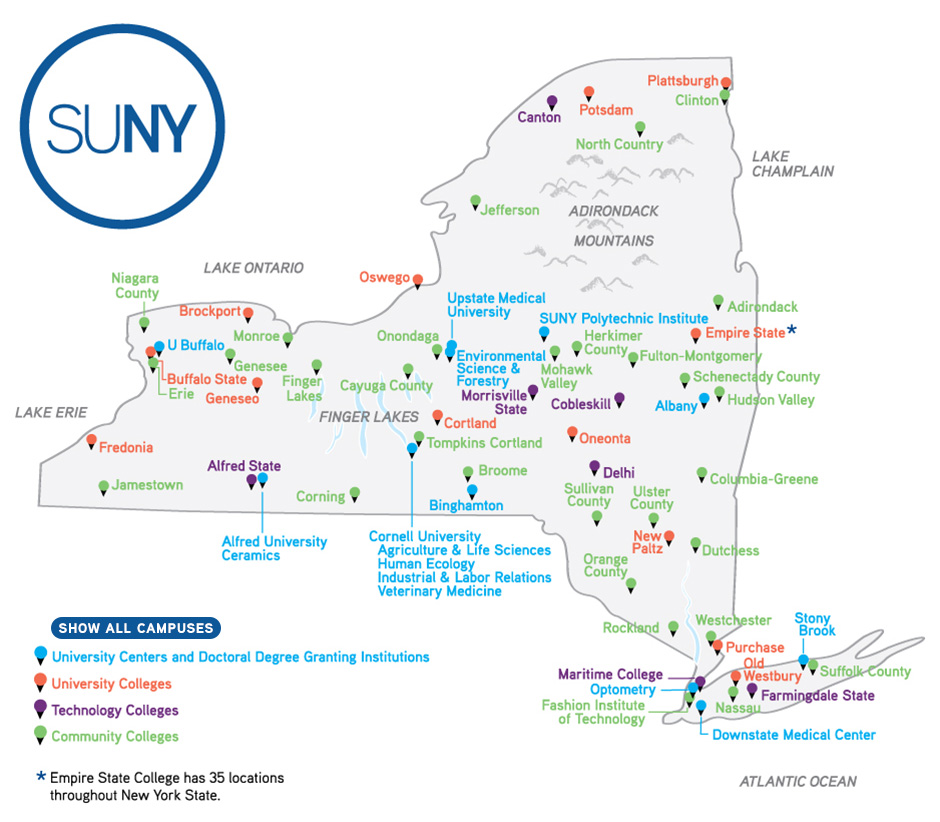Since the start of the course, I’ve been wondering how big a role the State University of New York (SUNY) should play in the final project. While it is a large and complex system, Geneseo maintains a distinct identity while simultaneously being a part of that system. With this in mind, I’ve decided to look at the effects of the Servicemen’s Readjustment Act of 1944 (also known as the G.I. Bill) at the state (SUNY) and local (Geneseo) levels.
SUNY was established in 1948, only two years after a commission on the matter was established, in direct

SUNY’s current campuses
response to increased access to higher education made possible by the G.I. Bill. Governor Thomas E. Dewey noted that private institutions in New York would not be able to contain the expected surge of veterans, making greater organization at the public level necessary (Mahood 146). However, despite (and perhaps because of) the rapid speed at which SUNY was established, there was a great deal of confusion and discord surrounding the institution during its founding and the first few years of its existence (Mahood 147).
In Geneseo, the impact of the G.I. Bill were not immediate, with only gradual increases in enrollment from the 1946-47 year until the 1957-58 year, which saw an increase of over two-hundred and fifty students from the previous year; however, the 1953-54 year saw a concerning drop in enrollment from the previous year (Mahood 311). The eventually significant growth of the student body meant that the long-awaited dormitories, construction of which had been put off during World War II, were all the more necessary (Mahood 148). Despite ongoing battles with SUNY and the state legislature for funding, thirteen dormitories were built on campus between 1950 and 1970, as well as several academic and administrative buildings (Mahood 316).
The murkiest of the effects of the G.I. Bill was the SUNY’s mandated conversion of Geneseo, as well as the other public teachers colleges, into liberal arts colleges. Mahood describes the initial designation as a “multipurpose college,” and I feel that this better reflects the intent of the G.I. Bill, which I read as having a greater focus on educating veterans for a specific place in the workforce (Mahood 167). “Multipurpose” seems to be a less constricting description than “liberal arts,” which brings to mind a much more defined purpose and curriculum. Additionally, there did not appear to be any initial deemphasis of Geneseo’s education programs, which fit in closely with my reading of the G.I. Bill’s intentions.
Patricia Gumport’s study in the trends of higher education report that the number of Baccalaureate-Granting Institutions (of which I consider Geneseo to be at least at the time of Gumport’s study) generally decreased throughout much the latter half of the twentieth century, making Geneseo’s increasing success during the same time period all the more fascinating (14). I hope to further explore this surprising success, as well as Geneseo’s occasionally contentious relationship with SUNY (mostly due to funding issues) as I continue my research with the general trends of higher education in mind.
Works Cited
Gumport, Patricia J., et al. “The United States Country Report: Trends in Higher Education from Massification to Post- Massification.” Academic Reforms in the World: Situation and Perspective in the Massification Stage of Higher Education, 1997.
Mahood, Wayne with Frederick Bright, Judith Bushnell, Paul Hepler, and James McNally. SUNY Geneseo: From Normal School to Public Ivy, 1871-2007. The Donning Company Publishers, 2008.

Leave a Reply